At Invictus, we believe in power of innovation. STEAM has proven to be one of the most popular (and effective) approaches to learning. Its trendiness can be explained by its ability to provide opportunities for integration of hands-on learning and team work, with the use of problem-solving approach. STEAM stands for Science, Technology, Engineering, Arts, and Mathematics. One STEAM activity dipping into these five different subjects allows students to develop their critical thinking, number and math operations awareness, artistic skills and (basic for younger learners) scientific knowledge.
在茵维特,我们相信创新的力量。STEAM被证明是最受欢迎(也是最有效)的学习方法之一。它之所以可以这么流行,是因为它提供了综合实践学习的机会,并且使用解决问题的方式为团队合作提供了机会。STEAM代表科学、技术、工程、艺术和数学。一项浸入这五个不同学科的STEAM活动,可以让学生发展他们的批判性思维,数字和数学运算意识,艺术技能和(初级学习者)科学知识。
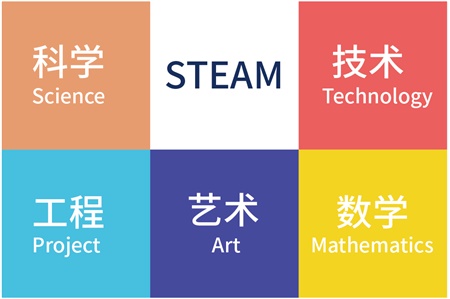
In our K1 classroom, we have been looking into basic coding. The foundations of coding are all about mastering how to think through and solve problems step by step. Later in life this knowledge can serve as a base for learning computer programming and algorithms.
在我们K1,我们一直在研究基本的编程。编程的基础是掌握如何思考并一步一步地解决问题。在以后的生活中,这些知识可以作为学习计算机编程和算法的基础。
We started our lesson with learning directions first. The students needed to know words such as ‘up’, ‘down’, ‘right’, and ‘left’ in order to successfully finish the task. We’ve learned new vocabulary and practiced it by playing a guessing game with an arrow.
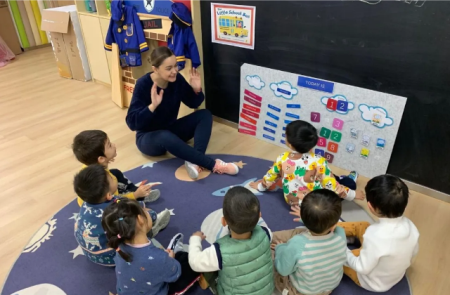
首先,我们从学习方向开始了我们的课程。学生们需要知道“上”、“下”、“右”和“左”等单词,才可以成功地完成我们的活动。我们学习了这些新的词汇,并通过玩一个猜箭头指向的游戏来进行练习和巩固。
Then we looked at ants and their homes as our activity was directly connected to them. The kids discovered how ant-houses look and the ways little ants make a lot of paths in the ground to accommodate the needs of their colony. We have also learned that ants eat crumbs of food and dead insects that they find and bring back to the ant-house.
然后我们观察了和我们今天活动密切相关的蚂蚁和它们的家。孩子们探索了蚁巢的样子,并且观察到了小蚂蚁在土地里开辟很多道路,以适应蚁群的需要。我们还了解到,蚂蚁的食物是人类食物的残渣和被它们找到并带回蚁巢的死昆虫。
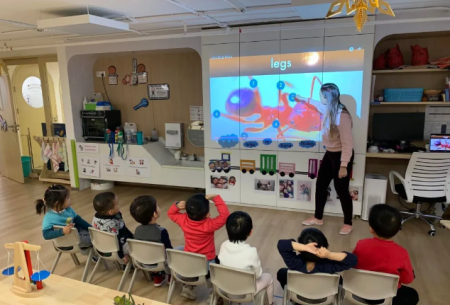
The students shared their admiration of ants, their small size and incredible strength. We decided to help a little ant find some food. The projected on the screen set of squares had an ant and some foods for him to choose. Our students discussed at what food the ant would eat first (hamburger), and how he can get there using the directions they have learned before (go right, go up, go right, go right again and eat!).
孩子们分享了他们对蚂蚁的钦佩之情,虽然它们的体型小巧,但是却力量惊人。幼儿们决定帮助一只小蚂蚁找到一些食物。通过投影,屏幕上出现了一个5X4的方格,里面有一只蚂蚁和一些可供选择的食物。我们的学生讨论了蚂蚁先吃什么食物(比如:汉堡包),以及蚂蚁该如何到达食物那里,通过使用孩子们刚刚学习过的方向(往右走,向上走,往右走,再往右走,然后吃!)。
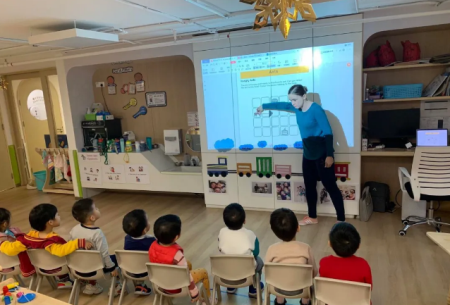
If our ant is still hungry, he can go find his next meal! How can he get there? Students had to use the new vocabulary to lead the ant to his new goal.
如果我们的蚂蚁还饿,它可以去去寻找它的下一个食物! 那蚂蚁该怎么去到食物那里呢?学生们必须使用新的方向词汇来引导蚂蚁找到到它的新食物。
After that, we reviewed our coding skills individually by marking the paths for the ant to take to find delicious treats with crayons. Some students came to a conclusion that there are multiple ways to get to the same goal! There are also short ways and long ways for the ants to go.
之后,我们通过用蜡笔画出小蚂蚁寻找食物的路线的活动来复习我们的编程技能。学生们得出这样的结论,有多种方法可以达到相同的目标!比如,蚂蚁可以走很短的路找到这种食物,或者也可以走很长的路才能找到这种食物。
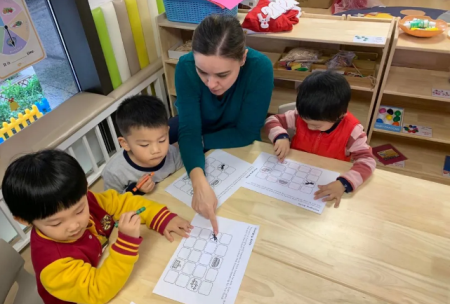
Well done, K1 class! The ant is full now and even has some foods to bring back to the colony to share! We, in our turn, learned the directions vocabulary, how to plan and carry out a step-by-step path to the goal, and discovered lots of facts about ants!
K1 班的小朋友们,表现得真棒! 这只蚂蚁现在已经吃饱了,甚至还有一些食物可以带回蚁群分享! 这节课上,我们学习了方向词汇以及如何计划和一步步地实现目标,并发现了许多关于蚂蚁的事实!
In today's STEAM class, the children have learned the science of ants. In technology, the students explored logical sequencing. In math, they begin to develop a sense of direction. As a next step, we will continue to explore the topic of ants using technology, such as Ant Puppet, to deepen the children's understanding of shapes and ant’s body structure in science.
今天的STEAM课上,从科学方面来说,小朋友们初步认识了解了蚂蚁;从技术方面来讲,小朋友们开始学习逻辑顺序;在数学上,孩子们开始发展对方向的认知。接下来的课程,我们还会继续对蚂蚁进行探索,比如Ant Puppet, 来锻炼小朋友们对数学形状的理解,以及科学方面蚂蚁的身体构造等。